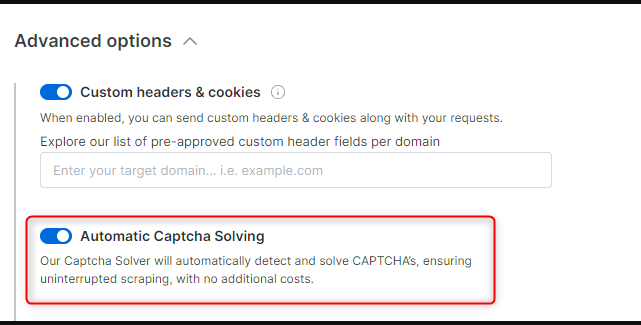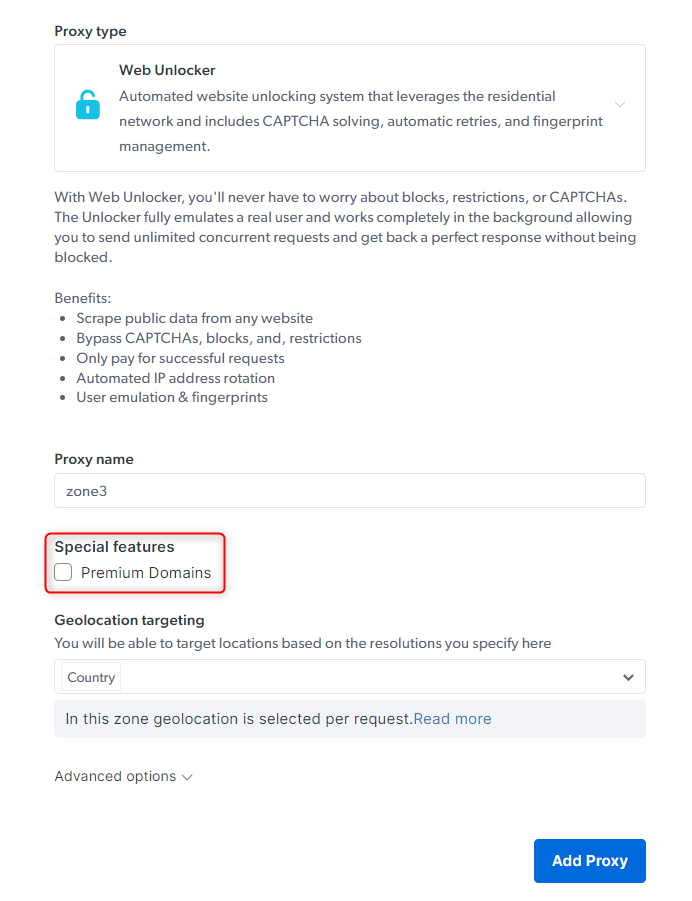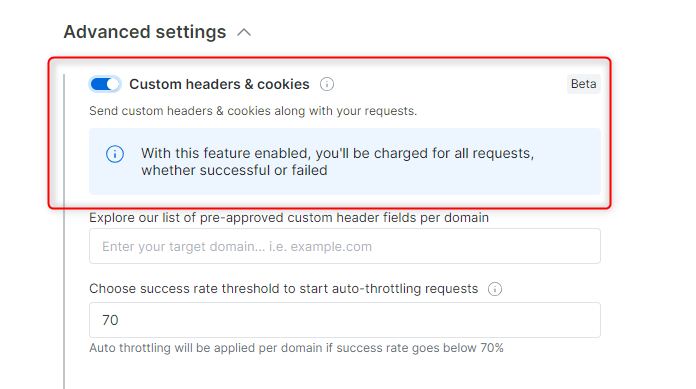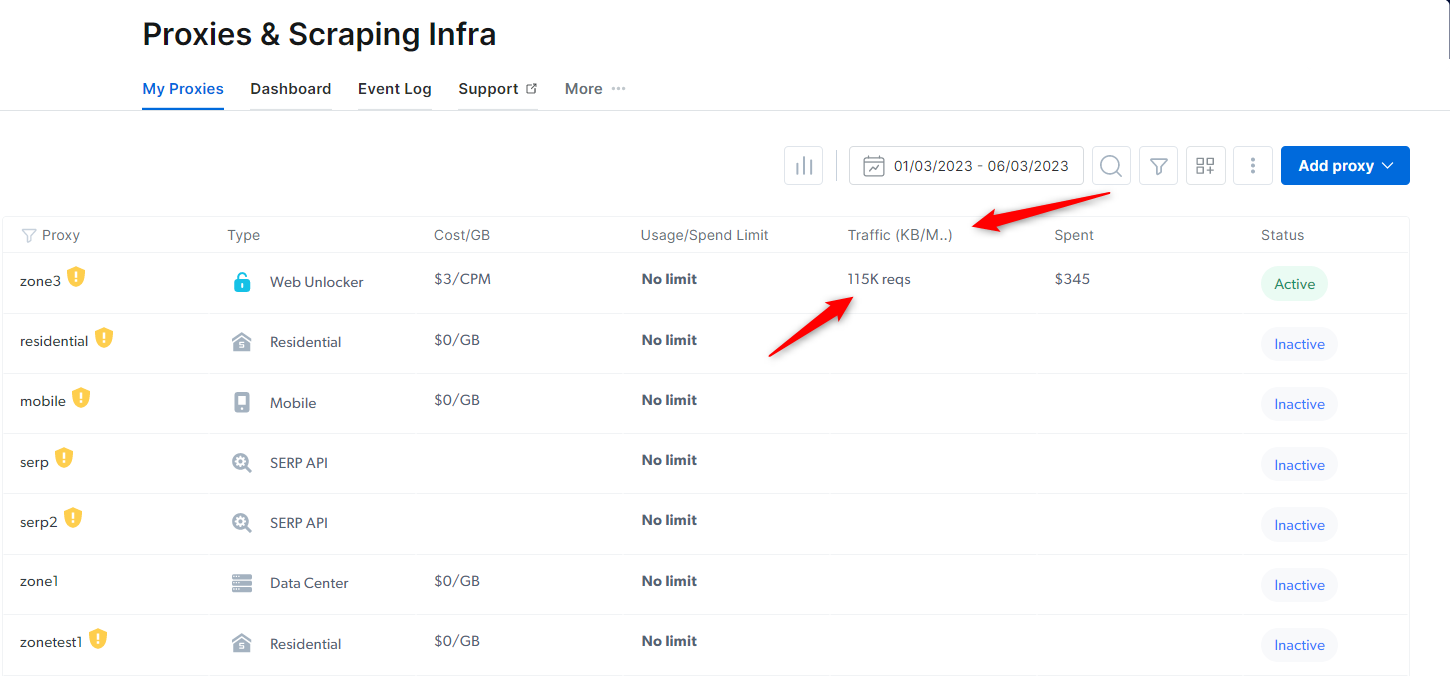Disable CAPTCHA Solving
By default, as part of our full proxy unblocking solution, Web Unlocker API also solves CAPTCHAs that are encountered while returning your proxy request. When disabling CAPTCHA solver, our intelligent algorithm still takes care of the entire ever-changing flow of finding the best proxy network, customizing headers, fingerprinting, and more, but intentionally does not solve CAPTCHAs automatically, giving your team a lightweight, streamlined solution, that broadens the scope of your potential scraping opportunities. Best for:- Scraping data from websites without getting blocked
- Emulating real-user web behavior
- Teams that don’t have an unblocking infrastructure in-house and don’t want their scraper to solve CAPTCHAs automatically
How can I get started?
How can I get started?
To disable CAPTCHA solving just open the relevant zone, go to the ‘configuration’ tab and open the advanced settings where you will find the ‘Automatic Captcha Solving’ controller. To disable CAPTCHA solving just switch off the toggle.

Web Unlocker API Premium Domains
Premium domains are a part of Bright Data’s tiered website classification system. These are websites that are more challenging to unblock than others and require additional Web Unlocker API resources. In this article, we will see the current list of Premium domains, understand how to target them, and go over the special pricing.The premium domains list is updated quarterly using our website classification logic and we’ll notify you via email 30 days in advance of any changes to your domains. You can always access the most up-to-date list in your Web Unlocker API zone.
Current List of Premium Domains
Expand to view current premium domains
Expand to view current premium domains
Enable Premium Domains
When creating your Web Unlocker API zone, check the ‘Premium Domains’ box under Special features
Pricing
Once enabled, the premium price will be reflected in the “Estimated cost” section. Check out the pricing page to see exact numbers, but keep in mind these prices are usually for “Pay as you go” plans and you can enjoy significant discounts if you sign up to a package or talk to our sales people!Even after enabled, only specific requests to these domains will be priced at the higher rate. Requests to other domains will be kept at the default lower tier.
Geolocation Targeting -country-country_code
If you want to target from a specific country in Web Unlocker API refer to geolocation targeting.
Mobile User-agent Targeting -ua-mobile
By default, Web Unlocker API uses desktop-specific user agents for your requests. To use a mobile user agent instead, simply append -ua-mobile to your request.
Scrape as markdown
Web Unlocker is able to live convert your pages from HTML to markdown. This makes it easier to feed your LLM training system, for example. To activate the feature, add thex-unblock-data-format: markdown header when using the native proxy interface, or set data_format: 'markdown' when using the API.
Return a screenshot
Web Unlocker is able to take a screenshot of the page you are trying to scrape. This can be useful for debugging or for monitoring the page’s appearance. To activate the feature, add thex-unblock-data-format: screenshot header when using the native proxy interface or add data_format: screenshot to request body when using API interface.
Output format is .png
Custom Web Unlocker API
Gain enhanced control over your requests with flexible options to fine-tune website behavior and optimize request handling. By default, Web Unlocker API automatically manages all request headers, cookies, expect elements etc., to get the best known results and any extra elements that are sent along with the request are disregarded. Custom Web Unlocker API allows you to override the automated parameters and send your own custom values specific to your needs.Custom features:
How to enable
In the Control Panel, go to your specific Web Unlocker API zone -> Configuration -> Advanced Settings, and enable the Custom Web Unlocker API feature you want to use.
Billing
Unlike the regular Web Unlocker API billing logic, which only charges for successful requests, when any of the above Custom Web Unlocker API features are enabled, you’ll be billed for 100% of the requests (both successful and failed). Since you are now in control of certain request paramaters, Bright Data can no longer take full responsibility for the unlocking process and its performance.Manual headers & cookies
Override automated headers/cookies and send your own custom values in order to target specific versions of a website.Enabling Custom Headers & Cookies results in the following
Access to Pre-approved List of Headers/Cookies
Access to Pre-approved List of Headers/Cookies
Send Request for New Headers/Cookies
Send Request for New Headers/Cookies
Charging for All Requests
Charging for All Requests
Unlike the regular Web Unlocker API billing logic, which only charges for successful requests, enabling this feature means you’ll be charged for 100% of the requests (both successful and failed). This change is due to Bright Data not having full control over the process and its performance.
Manual ‘expect’ elements
In case of receiving partially rendered/loaded pages, you can use thex-unblock-expect header to instruct Unlocker API to wait for specific elements or text before returning the response.This feature allows you to define expectations—such as a CSS selector, specific text, or the page body—that must be present before the page is considered fully loaded. You can configure this per request with the
x-unblock-expect header seen below.
Add header
Amazon-specific geolocation headers
Unlocker API allows you to pass custom headers to simulate a user-selected city and ZIP code on Amazon, enabling access to region-specific content, pricing, and delivery options.x-unblock-city- Simulates selecting a city.x-unblock-zipcode- Simulates selecting a ZIP code on Amazon.
Monitor Web Unlocker API Usage
To review your current Web Unlocker API CPM, navigate to My Proxies page, and review the Traffic column.
Understanding usage
The number displayed in the traffic column above is the number of successful requests. In the example above, 115k requests are equal to 115 CPM, so you’ll be billed according to the rate of 10 CPMs for that billing cycle.How is usage calculated?
Your Web Unlocker API usage is measured by CPM. CPM is the cost of 1000 successful requests, meaning only successful Web Unlocker API requests will count toward your billing. See our Billing & Pricing page to learn more.Debugging Web Unlocker API
Sometimes it’s useful to extract some debug info about your requests to understand what happened inside them in more detail. We provide thex-brd-debug header for this purpose.
To activate the headers, add -debug-full to your proxy username.
This feature is only available for the Unlocker API and is NOT available for our proxy products.
Enabling debug headers in your request
x-brd-debug header looks like this:
| Field | Description |
|---|---|
| req_id | The internal ID of your request into our system. Providing this can be helpful in bug reports as it will help us see details on what happened in your specific request. |
| bytes_up | The amount of outgoing traffic our system recorded while processing this request |
| bytes_down | The amount of incoming traffic our system recorded while processing this request |
| billed | Whether our system considers this a billable request or not |
| destination_ip | The IP address of the remote server used to fetch this data |
| used_req_headers | Which request headers (if any) were used in the final request. This mainly applies when using Custom Web Unlocker API |
| peer_ip | A unique identifier for the IP address used to make the request. This is mainly useful to validate IP rotation is working as you expect |
| peer_country | The country of the peer that was used for the request |
| render | Shows whether the returned page is the result after a browser rendered the HTML or the response body of a single HTTP request |
Common Error Codes
Occasionally, for a number of reasons, you might receive an unexpected error code in response to your Web Unlocker API request. The following list will provide you with a deeper understanding of what the source of the issue may be.| Error | Description |
|---|---|
404 | Page not found. Invalid URL, which suggests the URL might be broken or dead. |
| 403 | The URL you’re trying to access is valid, but you are forbidden from accessing that URL. |
| 502 | Error code 502 is the most common error for Web Unlocker API users, the descriptive part is under the x-luminati-error-code. |
407 | This error code suggests one of your account credentials is incorrect (password or zone’s name). |
429 | This error code implies a rate limit (rare). In such cases, if the response appears as below, Bright Data is applying auto-throttling to the request, and you should open a ticket or email [email protected] for assistance. |
401 411 444 | Bad request, usually happens in API requests when headers or cookies missing. |
503 | HTTP error code 503 means “Service Unavailable”. Browser check failed or browser check wasn’t completed |
Contact support for further assistance
Contact support for further assistance
If you encounter an issue with Web Unlocker API, before reporting it to us, please test with the instructions and tips below:
- Open ‘API & Examples’ in your control panel
- Select
curland your Web Unlocker API zone - Paste the URL of your target in the ‘URL’ box
- Copy with the button on the right
- Add
-v -o testto your command (this will turn on verbose logging, and create an output file named ‘test’ for you to share with our support agents) - Run the command and check the output (make sure to check the static source HTML for the data also)
- The
curlrequest you sent to generate the result - The full verbose output from running the command
- The response returned from running it (the ‘test’ file)
- Whether you are using a browser automation tool or not (The Web Unlocker API does not support them or any 3rd party integrations except for your code).
Get Success Rate Statistics Per Domain
The following API endpoint will provide Web Unlocker API success rate statistics from the past 7 days. The statistics can be obtained per single domain likeexample.com or for a wildcard domain like example.* in order to get statistics for all top-level domains.
Note: calling this API endpoint requires using your
API key
How to get statistics for a single domain?